Preventative dentistry is about more than just visiting your dentist twice yearly for an examination and thorough cleaning. In fact, the majority of your preventative care is done at-home as a part of your normal hygienic routine. Many residents use manual toothbrushes to remove debris and plaque from their teeth. However, electric brushes have become widely popular in recent years, leaving some to wonder whether one type is better than the other.

Frequently Asked Questions
You can effectively brush your teeth with either a
manual toothbrush or an electric one. However, the
rapid movements of motorized versions may be more
effective at removing plaque from the teeth and gum
line. If you have questions about which toothbrush is
best for you, speak with your dentist about it at your
next visit. He or she may recommend an electric brush
with an oscillating head or a brush that includes a timer
to let you know how long to brush.
Regardless of whether you choose an electric brush or
a manual brush, it should be easy for you to maneuver
in your mouth and behind your back teeth. If the head
is too big, it may not be effectively removing plaque
from your teeth.
Yes. Your toothbrush should be replaced at least once
every three to four months or whenever you notice
fraying. However, most electric toothbrushes come
with interchangeable heads. In other words, you won’t
need to replace the entire device – only the brush
itself.